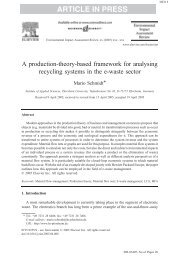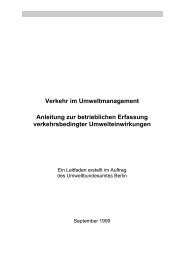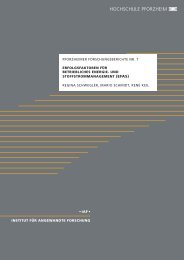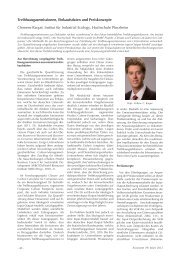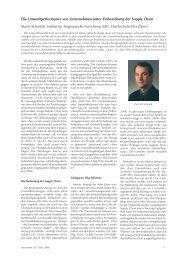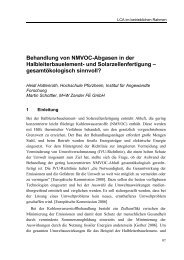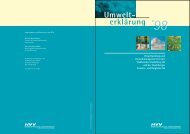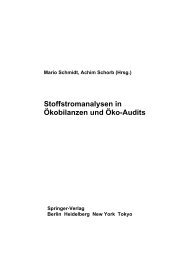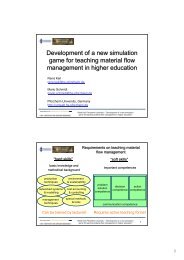Life Cycle Assessment of PET (Polyethylene Terephthalate) bottles ...
Life Cycle Assessment of PET (Polyethylene Terephthalate) bottles ...
Life Cycle Assessment of PET (Polyethylene Terephthalate) bottles ...
You also want an ePaper? Increase the reach of your titles
YUMPU automatically turns print PDFs into web optimized ePapers that Google loves.
Figure 1: The recycling <strong>of</strong> “<strong>PET</strong> material<br />
recycling <strong>bottles</strong>”<br />
possible to carry out a basic comparison <strong>of</strong><br />
beverage packagings with different volumes.<br />
Despite this, a distinction was made<br />
between systems from stock-keeping sectors<br />
and systems for immediate consumption,<br />
since consumer requirements differ.<br />
In addition to the actual beverage packaging<br />
made <strong>of</strong> glass or <strong>PET</strong>, the labels and<br />
capsules as well as the transport packaging<br />
(bottle crate or tray) needed for 1,000<br />
litres <strong>of</strong> bottled material were taken into<br />
account.<br />
The systems considered are beverage<br />
packagings which are either already established<br />
in the market or have already<br />
been developed and successfully tested.<br />
Altogether 14 different systems made <strong>of</strong><br />
glass or <strong>PET</strong> were compared, including 5<br />
systems for immediate<br />
consumption with very<br />
small volumes (0.33 and<br />
0.5 litres) and 9 systems<br />
for stocking purchases<br />
with volumes <strong>of</strong> 0.7 litres<br />
and more. Only the results<br />
for the stock purchase<br />
sector are described below<br />
(Table 2).<br />
The "life cycles" <strong>of</strong> the<br />
product systems with the<br />
various stages from procurement<br />
<strong>of</strong> raw materials<br />
to waste disposal were<br />
described as process<br />
chains. The production<br />
and waste disposal <strong>of</strong> the<br />
beverage packagings<br />
themselves, <strong>of</strong> the transport<br />
packagings (e.g. crates, trays or<br />
wooden pallets), or important operating<br />
and auxiliary materials were taken into account,<br />
as well as the actual filling process<br />
and distribution and redistribution. The<br />
provision <strong>of</strong> the infrastructure (e.g. the<br />
machines or means <strong>of</strong> conveyance) and<br />
the production <strong>of</strong> the relevant material to<br />
be bottled, in other words the beverage,<br />
were not taken into account, inasmuch as<br />
they were independent <strong>of</strong> the packaging<br />
system.<br />
Alongside the process chain, a product<br />
system is only defined by a number <strong>of</strong> assumptions<br />
in the life cycle, e.g. distribution<br />
distances or recycling quotas. These are<br />
relevant for the results for the product system<br />
and must always be taken into account<br />
for comparison purposes. In other<br />
words, the entire production, consumption<br />
and waste disposal system <strong>of</strong> the product,<br />
including the so-called system parameters,<br />
must be described. In the case <strong>of</strong> assumptions<br />
on the life cycle, either real processes<br />
and system parameters were taken<br />
as a basis, or plausible assumptions were<br />
used, such as are used in the LCA for the<br />
UBA.<br />
One crucial stipulation within LCAs is<br />
the question <strong>of</strong> how the secondary raw<br />
materials are used or generated. Generally,<br />
an attempt is made to use secondary<br />
raw materials - in as far as they conform to<br />
real conditions - in a closed loop, e.g. in<br />
glass fragment use, the glass from broken<br />
glass <strong>bottles</strong> is used for production <strong>of</strong> new<br />
Table 3: Impact categories taken into account and the<br />
indicators used for them<br />
Resources<br />
Greenhouse effect<br />
Acidification<br />
Eutrophication<br />
crea-<br />
Photo-oxidant<br />
tion<br />
Noise<br />
Human toxicity<br />
Nature space used<br />
up<br />
Cumulative Energy Demand CED<br />
Crude oil resources equivalent value<br />
Process water consumption<br />
Global Warming Potential GWP<br />
Acidification Potential AcP<br />
Eutrophication Potential NP<br />
POCP or NCPOCP<br />
Lorry mileage<br />
Cancer Risk Potential CRP<br />
Landfill area<br />
Wood consumption<br />
4



